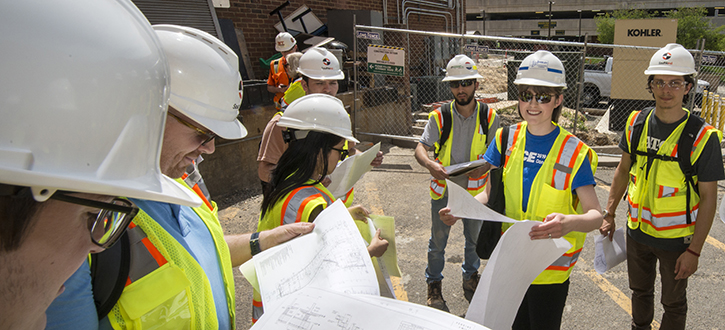
Laura Kosoglu, associate chair of the Sid and Reva Dewberry Department of Civil, Environmental, and Infrastructure Engineering, took students in her Foundation Design class to the construction site on the Fairfax Campus to watch the foundation being poured.
Civil engineering associate professor Laura Kosoglu lays the groundwork for students’ academic success in the classroom then builds on it with hands-on experiences in the field and lab.
“One of my goals is to create a strong foundation for students. Then they need to solidify that knowledge with practical experiences,” says Kosoglu, associate chair of the Sid and Reva Dewberry Department of Civil, Environmental, and Infrastructure Engineering (CEIE) and director of CEIE’s graduate program.
“Good teaching looks easy, but it’s not. The more effort I put into the course, the more students become engaged and learn.”
Her dedication to education earned her Mason’s Teaching Excellence Award in 2016, and she was selected for the 2019-2020 Leadership Legacy Program, designed for Mason full-time faculty and staff who are committed to furthering their leadership development.
Kosoglu has taught about 2,000 undergraduate and graduate students in the past eight years, sharing her expertise in geotechnical engineering. The field includes the mechanics of soil, foundation design, earth-retaining structures, and seepage and slope stability.
Students learn how to consider the subsurface of structures—the soil, geology, groundwater flow, water supply, soil strength, and settlement potential. “Water and soil are mud, so I tell my students they are learning about mud.”
Classes have a real-world feel.
- In Foundation Design, students don hard hats and go to a construction site. Last spring, they visited the building project on the Fairfax Campus to watch the foundation being poured.
- In Soil Mechanics, they roll up their sleeves and dive into soil experiments.
- In Geomatics and Engineering Graphics, they use a 3D laser scanner, GPS, and other surveying equipment to collect topographic data outside the engineering building, then they import that data into a 3D computer model to design sidewalks or bike paths.
- In Sustainable Land Development, they learn about solar panels, geothermal energy, green roofs, insulation, recycled materials, and rain gardens.
“The class is unlike anything they’ve taken before,” she says of the sustainability course. One project focuses on designing a low-impact, mixed-use development from scratch. The students consider sustainability, cost, safety, and aesthetics.
She is careful to pace her instruction. “Students need to learn the course material, but they cannot be loaded without support. Just as civil engineers calculate the stress induced by a structure, one of my jobs is understanding the stress I’m putting on my students and at what point they are overloaded,” she says.
The best part of teaching is interacting with students—watching them get excited about the subject matter and answering their questions in class or during office hours, she says.
Even more rewarding is when students tell her they decided to focus on geotechnical engineering as their concentration after taking one of her classes. “I’m humbled by that.”
"Students need to learn the course material, but they cannot be loaded without support. Just as civil engineers calculate the stress induced by a structure, one of my jobs is understanding the stress I’m putting on my students and at what point they are overloaded."
— Laura Kosoglu, associate chair of the Sid and Reva Dewberry Department of Civil, Environmental, and Infrastructure Engineering
